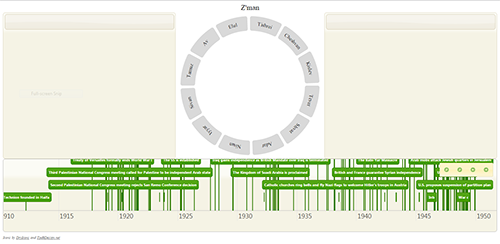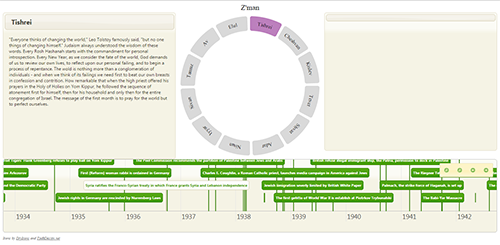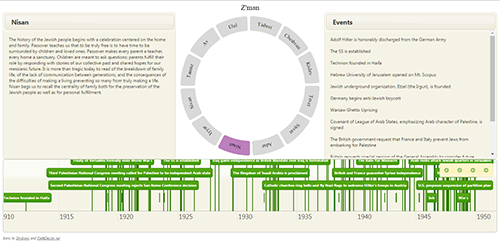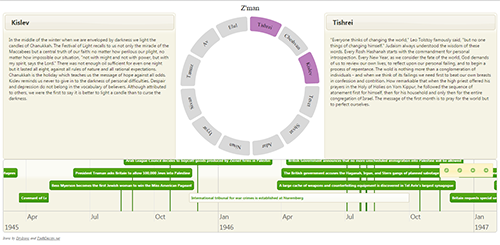Z’man Sheli is a visualization exploration of understanding world events through the lens of the Jewish concept of time. It features two linked timelines, one in the traditional linear sense with events plotted on a Gregorian calendar and the other, a circular timeline plotting events by their month on a Hebrew calendar. As a user selects an event on the linear timeline, the event’s Hebrew month is automatically selected on the circular one. In this way, the user is able to reframe his understanding of the event in the context of the energy of the Hebrew month. The user can also select a Hebrew month and get a chronologically arranged list of all of the events that occurred during this Hebrew month over the years. This view allows the user to look for any change, hopefully forward growth, over the years through the lens of the energy of the month.

This is the prototype with the two timelines before anything has been selected.

Selecting an event on the linear timeline highlights the Hebrew month on the circular one.
The current prototype implementation of Z’man Sheli deals with events in modern Jewish history beginning with the end of WWI. Although I wanted to include less recent events, I was limited in collecting the data because I needed events for which I had either the full Hebrew date or the full Gregorian date in order to be able to convert between the two. The other issue is that the Jewish calendar and the Gregorian calendar do not start at the same year. Therefore, while I might have the Hebrew date of an event, I can’t calculate the Gregorian date because it occurred before the first Gregorian year. Furthermore, I started with just events from Jewish history because I began collecting and converting the dates manually and so I needed some criteria for scoping the data I was collecting. However, the ultimate goal would be for users to input their own events into the visualization, hence the addition of the word ‘sheli’ (mine) to the visualization’s title. I assumed this would mean I would have to write my own date converter, until I discovered that this already exists after I had finished the prototype version.

Selecting a month on the circular timeline provides a description of the month and the events that occurred chronologically during that month over the years.

Selecting events that occur over a period of multiple days will highlight the months of the start and end of the event.
I plan on continuing this visualization as my final project from the class, ultimately allowing for user-provided events and enhanced exploratory and discovery support. One suggestion to help do so was to color-code events on the Gregorian timeline based on the Hebrew month the correspond to. Other ideas I want to play with include the ability to switch between Gregorian and Hebrew date labeling for the linear timeline and alternate ways of viewing the list of events occurring in different years during the same month.